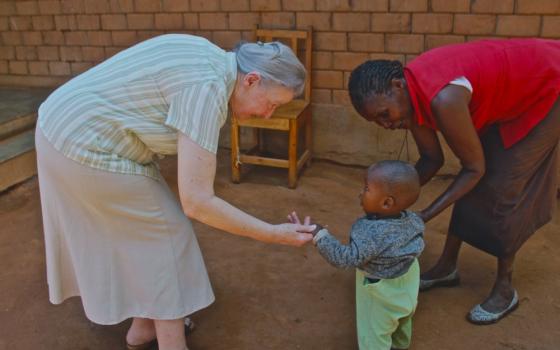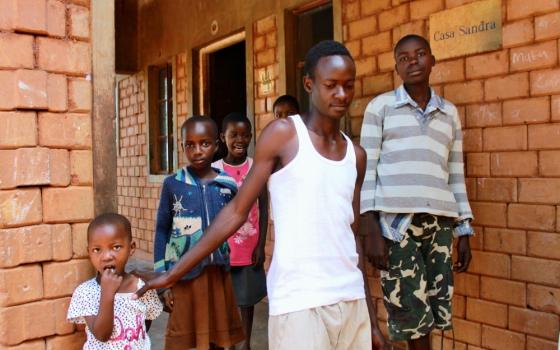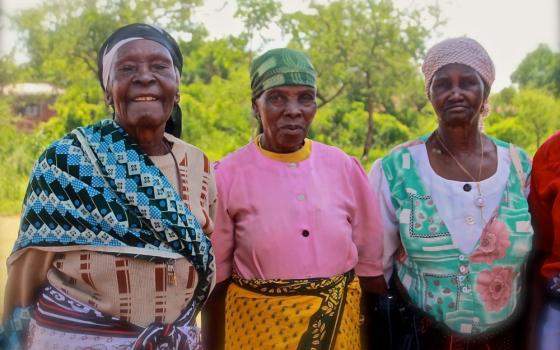In 2011, I began conducting interviews with Catholic sisters across America for my book, If Nuns Ruled the World, which was released last fall. After a great reception here and around the world, I realized this story was nowhere near finished. And so, I am beginning a new project profiling the work of Catholic sisters working in Africa for a second book and multimedia endeavor.
I plan to chronicle my reporting journey here, sharing stories, notes and thoughts while allowing the Global Sisters Report community to shape the direction of what I am working on. I want to hear your questions and your suggestions for this and future chapters. Talk to me by email at jo.piazza@gmail.com. I am all ears.
I completed my first trip to Nairobi in Kenya in December where I met with Sr. Mary Owens, IBVM, executive director of Nyumbani, a non-profit organization that cares for individuals infected with or affected by HIV/AIDS in Kenya.
______
Institute of the Blessed Virgin Mary Sr. Mary Owens doesn’t take no for an answer. Don’t get me wrong. She is a lovely woman, pleasant as can be. But it took only 15 minutes with her on one December morning to understand how she has become such a force in advocating on behalf of HIV orphans in Kenya.
That week I was staying in The Tribe, a luxurious hotel on the outskirts of Nairobi which I had no business staying in at all except for the fact that it was owned by a dear friend who thought it adorable that I was writing a book about Catholic sisters and wanted to help me out. My hotel stay came with a driver, Julius Mwangi, who dressed in all black – fine black pants and black turtleneck. I constantly wondered how Julius managed to keep his clothing so impeccable, without a trace of dirt or sweat, both of which I was covered in by sunrise. Julius drove a white Range Rover, as pristine as he, which we took to meet Owens in at 7 a.m. sharp.
I knew we would be traveling outside of the city. But I wasn’t sure how far. Julius had no idea what he was getting himself into. I’m still not sure he would have agreed to it if he had. Still, Owens was able to convince him to do just about anything. She carries that air of authority.
Owens arrived straight from 6 a.m. Mass looking smart in a tan linen skirt and green striped blouse, with a brown leather computer bag slung over her shoulder. She didn’t blink at the luxury vehicle. She just began firing off efficient directions to get us out of town to the Nyumbani Village, a self-sustaining community that supports both orphans and elders impacted by the AIDS pandemic about four hours away from the city.
Traffic was terrible, as it always is in Nairobi during any hour when the sun is in the sky. The peddler stalls selling blankets, beds, T-shirts, batteries and couches that lined the roads of Nairobi slowly gave way to lush rolling green hills as we inched out of the city. And Mary began to tell me the story of how Nyumbani began.
“These children are going to die anyway. Get into prevention.”
That was the response Owens and Fr. Angelo D’Agostino, known as Father Dag, received in 1991 when they approached an international aid organization for funding to create an orphanage in Kenya for children stricken with HIV.
“These children are going to die anyway.” Who says that?
What was left unsaid was that the sister and the priest should just let them die. Babies were being left in hospitals, then rejected by orphanages. Others were left in the streets to die alone, shunned by their extended families because of fear and ignorance. Hindsight is 20/20, and nearly 20 years later Human Rights Watch would chastise the country for neglecting the care of infected children. But at that moment Mary and Angelo were told to just let them die.
They couldn’t do it. And so in 1992 D’Agostino and Owens opened the first residential facility in Kenya to care for infected orphans. The sister and the priest opened their orphanage with five kids, who soon grew to 11 – mostly babies.
“In the early days we were burying three children a month,” Owens told me, staring out the car window. I could tell she was picturing each of them as she said it.
The concept of orphanages is contentious in Kenya, and in many African countries, where family is the core of a community. Children should be with their families, with any blood relative who can be located. But the children Owens and D’Agostino took in were unwanted, alone, not old enough to even attempt to fend for themselves.
The two created a model for a new kind of care. This model would bring together two generations that had their lives torn apart by the HIV pandemic, the two left-behind generations – children whose parents had died of the disease, and their grandparents, whose children had died.
Many of the grandparents they reached out to had already been caring for their grandchildren. They were aged and destitute. D’Agostino would pass away before he saw his dream of a planned community realized, but Owens invited people to come live in a new village that she was building. In return for housing and food and support, the grandparents would take in other children who had no family left.
“We ask the grandparent to care for them and love them as if they were their own,” Mary told me.
When I visited the village, there were 100 grandparents, mostly women, almost all over the age of 60, and 1,000 children.
Only about 9 percent of the children in the village are infected with HIV currently. But all of them have been affected, which means they lost their parents.
I’d never heard the term, “left behind,” before I met Owens. But it is common parlance in Kenya.
What “left behind” means becomes clear in the village where an entire generation missing. Old women, stooped over with the weight of a lifetime of injustice, carry toddlers and babies as young as two weeks on their backs. They gather in the village square to trade stories of recalcitrant teenagers and teething. It is the generation in between that is missing, and these are the ones who have been left behind.
Many of the children will never know another home.
“They came here in arms,” is how Owens describes it.
There is a waiting list – a big one, but they make exceptions for urgent cases. One of those was a report of four children found subsisting on wild berries. Neighbors didn’t have enough food from their own rations of famine relief and so the children, one of whom was mentally challenged, were forced to scavenge to survive.
They call these children “rescues.”
Owens knows that the children who come to Nyumbani Village are finally settled when they start being naughty.
“That is when they feel safe enough to behave like children,” she said. “They couldn’t do that when they were living in poverty and watching their parents die.”
I was there just before Christmas, when 16 rescue children needed to be admitted before the end of the year.
Owens walks briskly and with authority through the village, greeting everyone by name and speaking to them in the local dialect. They hug her and hand her babies for her to kiss and hold. She knows their names too, even the very new ones.
She knows their complicated handshake, one that I fumble with over and over again, same as I do their greeting, which sounds a bit like a vocalized sneeze, “Achaaa ahh.” The response is an “ahhh.”
“Ay,” I try opening my throat. The old women throw their heads back in laughter at the odd noise coming from my mouth.
“Ahhhhhhhhhhhh,” several of them open their mouths wide, making the softer sound, showing me.
“Ahhhhhhhhhhhhhhh,” I mimicked.
“You’ve got it,” they said with a brisk nod of approval.
[Jo Piazza is a journalist and the author of several books, including If Nuns Ruled the World: Ten Sisters on a Mission, published in September 2014 by Open Roads Media. Piazza is reporting this year for a book about African sisters. She welcomes your feedback at jo.piazza@gmail.com.]




